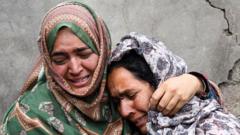The historic rivalry between India and Australia began with India's first Test tour in 1947-48, a journey marked by personal and national upheaval due to partition. Despite the challenges that arose from religious violence and trauma, the tour represented a significant moment in Indian cricket history, though it resulted in a 4-0 loss against Bradman’s team.
The Turbulent Origins of India's First Cricket Tour to Australia

The Turbulent Origins of India's First Cricket Tour to Australia
India’s inaugural cricket tour to Australia in 1947-48 unfolded amid the national turmoil of independence and partition, shaping a legacy that persists today.
India's first cricket tour to Australia in 1947-48 is a fascinating chapter in the evolution of cricketing rivalries, occurring against the backdrop of India's recent independence from British rule and the traumatic partition that led to the creation of Pakistan. This historic tour came at a time when India was grappling with internal strife, making it incredibly challenging for the 16-member squad to prepare for a formidable opponent like Australia.
President of the Board of Control for Cricket in India, Anthony De Mello, with a map of undivided India behind him, announced the team that would represent the entire nation. Until then, the Indian team had seen only limited overseas experience, touring England for Test matches on three occasions but failing to secure a victory.
A turning point occurred in 1946 when a team led by future Australian captain Lindsay Hassett visited India, where they played three unofficial matches and lost one to the Indian squad. This unexpected outcome reshaped perceptions and led to the recognition of Indian cricket as a serious competitor, setting the stage for the official series in Australia.
Excitement built in India as the squad prepared to face “Bradman’s Invincibles,” led by the legendary Australian cricketer who boasted an undefeated record. Key Indian players included opening batsman Vijay Merchant and his deputy Mushtaq Ali, both seasoned veterans of earlier tours. However, unforeseen personal and national adversities led to their withdrawal from the tour, which resulted in Lala Amarnath stepping in as captain.
The violence of religious sectarianism following partition put extreme pressure on players. Amarnath faced life-threatening situations, including a near-attack by a mob, which underscored the chaos throughout the country. His close shave with death emphasized the stark realities faced by the players even as they aimed to focus on their cricketing duties.
Fazal Mahmood also confronted danger, almost succumbing to violent threats during his travels. While the team attempted to conduct two weeks of training in Pune, escalating unrest left many of the players shaken. Mahmood ultimately chose to remain in Pakistan rather than proceed with the tour. Two other squad members also relocated to Pakistan and participated in subsequent matches against India.
Despite these setbacks, the tour proceeded, marking India’s first-ever test series in Australia. Ultimately, the team lost to the Australians by a margin of 4-0, yet the significance of the tour transcended the scoreline. It became a testament to tenacity and the emerging spirit of national pride in a country healing from one of its most tumultuous chapters.
Today, the rivalry between India and Australia remains one of the most anticipated events in cricket, often compared to the famed Ashes series. The struggles faced during that inaugural tour of 1947-48 have echoed through history, contributing to the rich tapestry of cricket that brings the two nations together.





















